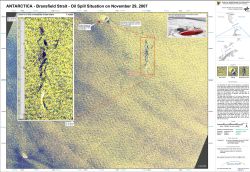- Startseite
-
About us
-
Crisis Information
- Crisis Information
- Overview
- Mapping and Exercises
- Monitoring Services
-
Services and Projects
-
Latest
- EnglishDeutsch
- Accessibility
- Press
Oil spill in Antarctica from sunken ship MV Explorer
undefinedOn November 23, 2007, the MV Explorer, an adventure travel ship, hit an iceberg whilst passing through pack ice in the Bransfield Strait about 50 nautical miles south of King George Island, Antarctica, forcing its 154 passengers and crew into lifeboats in the middle of the night. When the MV Explorer sank, about 190,000 liters of diesel oil, 24,000 liters of lubricant and 980 liters of gasoline were on board. Two days after the sinking, a 5 sqkm area of sheen was reported, which represents a few cubic metres of oil at most. Reports suggested that oil sheen continued to be observed in the vicinity of the sinking location and its appearance and cover corresponded to a slow and steady release of fuel from one or more tanks onboard the vessel. Areas surrounding the spill site include breeding grounds for Antarctic and Adelia penguins, and the largest mating colony for Papua penguins. In addition to penguins, the spill could have also affected other Antarctic fauna, including seals, sea birds and sea lions as well as fish, krill, algae and plankton colonies. On November 29, 2007, at 8:31 UTC, TerraSAR-X data of the area was acquired in StripMap-mode. The scene covers about 15x50 km and was recorded in dual-polarization mode (VV and HH). The DLR radar satellite TerraSAR-X, which was launched in June 2007, proved once more its suitability for the detection of even small-scaled oil pollution. Independent of cloud cover or daytime, TerraSAR-X was able to deliver high quality data with a resolution of up to one meter.
Products
Antarctica - P01 - Oil spill on November 29, 2007
Creation Date 20. December 2007
Further links



